The Gatling is commonly seen as the first manual machine gun used by the US military, but it was preceded by several other designs, including the Union Repeating Gun. Also known as the Ager Gun or the Coffee Mill Gun, it was a single-barrel crank operated weapon developed prior to the adoption of self-contained cartridges.
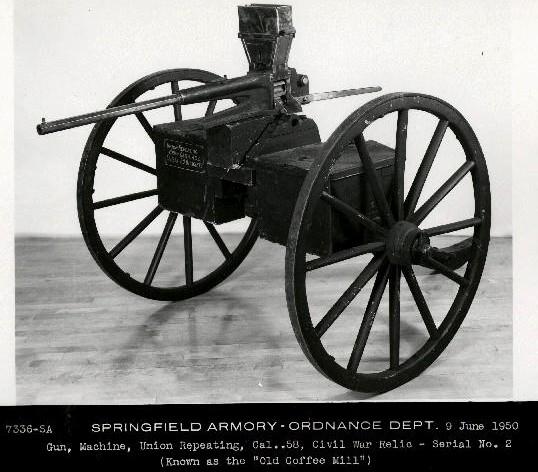
Without reliable and suitably powerful (the early rimfire cartridges were fairly anemic compared to contemporary muzzleloading charges) self-contained cartridges, the task of developing a reliable and effective repeating weapon was quite difficult. The method used by the Union gun was to use steel cylinders to act as both cartridge and chamber – not unlike the English Treeby repeating rifle of roughly the same time. Each cylinder would be loaded with powder, wad, and projectile (or a premade paper cartridge) and have a percussion cap affixed to its back face, much like a modern primer. These loaded cylinders would then be loaded loose into the hopper atop the gun. Turning the gun’s crank would rotate a cylinder to pick up cylinders from the hopper, move them into firing position, move a locking wedge into place behind to more or less seal the breech, release a hammer to fire the round, drop the locking wedge out of engagement, and drop the now-empty cylinder out the left side of the gun. Those cylinders would be collected and reloaded – this system was also closely copied by the very first Gatling guns, before brass-cased cartridges became available.
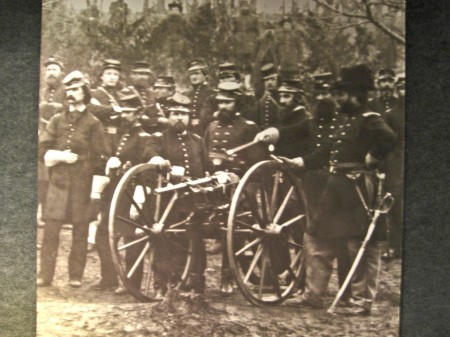
The Union Repeating Gun had the luck of being one of the first guns of its type proposed to President Lincoln and the Union Army. Lincoln was something of a gun nut himself, quite interested in new technology. He took a personal interest in the gun after seeing it demonstrated in New York in the summer of 1861, and personally ordered 10 of them over the objection of the Ordnance Department. A further order of 50 more guns was made by General McClellan. The guns performance was mixed, and they saw use only in a handful of engagements. Certainly, they were not the decisive weapon Lincoln had probably envisioned, and that letdown would temper his enthusiasm for new weapons throughout the remainder of the Civil War. In addition, General Ripley (head of Ordnance) was adamantly opposed to the adoption of any new technology on the grounds that new designs were unproven and could not be relied upon, and resources were better spent mass-producing the tried-and-true percussion muskets that the Army was accustomed to.
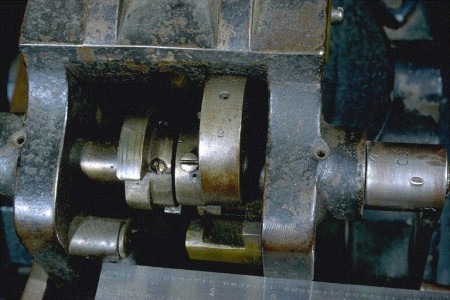
The Union Repeating Gun was a reasonably reliable piece, considering the limits imposed by its ammunition. It had an effective rate of fire of 120 rounds/minute, although it was quite susceptible to overheating because of its single-barrel design. Interchangeable barrels were introduced to alleviate this issue, and a forced-air cooling system (using a fan linked to the firing crank) was designed but never produced. Consider that the standard load for the weapons was a .58 caliber Minie ball propelled by a 750 grain charge of black powder – that is a lot of heat building up in a single barrel. In fact, one test was observed by Colonel G.V. Fosbery (of Webley-Fosbery repute), who reported that:
…when firing at the rate of 100 discharges a minute, the flame of 7,500 grains of exploded powder and nearly 7 pounds of lead would pass through a single barrel in that time. The effect during the trial proved that the barrel first grew red and nearly white hot, and large drops of fused metal poured from the muzzle, and the firing had to be discontinued from fear of worse consequences.
(source: Chinn)
Getting a repeating gun reliable enough to get that hot was no trivial feat in the 1850s or 60s. However, the steel chamber cylinders never provided a perfect seal, and leaking gas could pepper the operators with small hot debris, as well as reducing the ballistic efficiency of the ammunition. The gun had an overall length of 56 inches and a 35 inch barrel, being mounted on a two-wheel carriage like a small artillery piece (which is how the military treated these sorts of guns at the time). Its maximum effective range was 800-1000 yards, although its lack of accuracy made it effective only against formations at that range. In formal testing, one sample was fired at a board fence measuring 60 yards long and 7 feet tall, and made 40% hits at 400 yards.
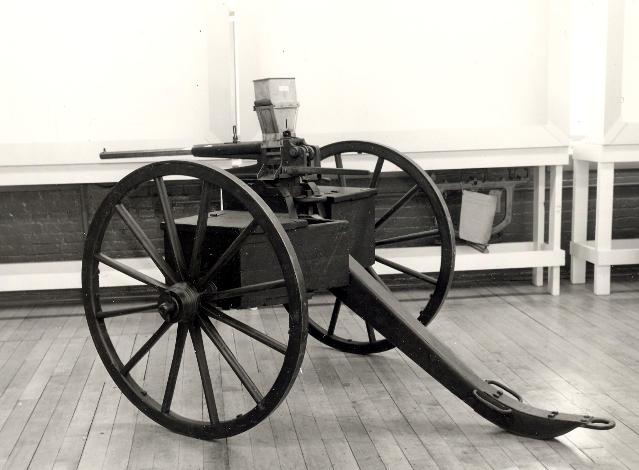
Union Repeating Guns were present at the battles of Harper’s Ferry, Middleburg, Yorktown, Warwick, and probably others – a captured one was used to fire on a Union observation balloon near Reams’ Station VA in 1864; possibly the first antiaircraft use of a machine gun (source: Pritchard).
The name “Ager Gun” comes from a sales agent for the gun in England named Wilson Ager, who filed a patent for it in England. The “Coffee Mill Gun” moniker comes from the appearance of the gun and its feed hopper. The actual designer is a bit uncertain, but is probably either William Palmer or Edward Nugent (or both of them working together). The guns were manufactured by the American Arms Company, which had been formed specifically for this gun. After the end of Civil War hostilities, the guns were sold off as surplus, less a few kept in arms collections.
Photos
A modern reproduction of the Union Repeating Gun sold at auction for $16,000 in 2013. Here are some photos of it, from Amoskeag:

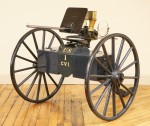
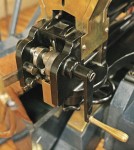
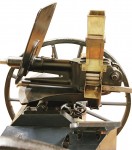
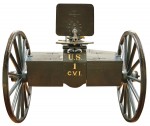
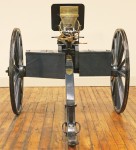
“the standard load for the weapons was a .58 caliber Minie ball propelled by a 750 grain charge of black powder”
“when firing at the rate of 100 discharges a minute, the flame of 7,500 grains of exploded powder and nearly 7 pounds of lead would pass through a single barrel in that time.”
Wouldn’t 7,500 grains / 100 discharges = 75 grains? A 750 grain charge for one minnie ball seems excessive.
Given that the figure given for the weight of lead comes to a bit under 500 grains per projectile when divided by 100, which is right in the range for a .58 Minie ball, I believe it’s safe to assume that each was propelled by 75 grains of powder. A powder charge of ~75 grains is also in the range I’d expect to see for something like this, which further corroborates it.
Does anyone know from where I can obtain measured/scale drawings of the Ager gun. I want to craft a 1:16 scale, non-functioning scale model for reproduction.
Does anyone know the weight of the metal cartridge? If I had the weight I could figure out how many of these was stored in the ammo box that was on the axle tree. There were two – one empty & one with cartridges. I assume the limber would have two or three ammo boxes.
General Stonewall, during the Campaign of the Valley, defeated General Fremont and captured a large amount of equipment. Amongst the spoils were fourteen of these early machine guns, however, the idea of them hadn’t truly been realized yet and they were left in a warehouse somewhere. Source: Mighty Stonewall, Vandiver. 1957.